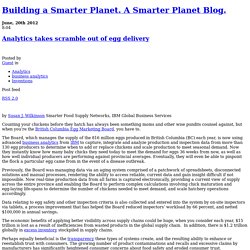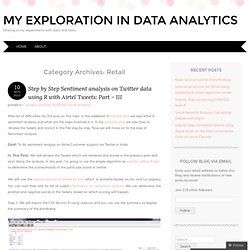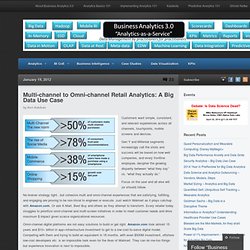

Business Intelligence for Retail with KPI for Retail Industry. Enterprise IT Services Company.
Analytics takes scramble out of egg delivery. By Susan J.

Wilkinson Smarter Food Supply Networks, IBM Global Business Services Counting your chickens before they hatch has always been something moms and other wise pundits counsel against, but when you’re the British Columbia Egg Marketing Board, you have to. The Board, which manages the supply of the 816 million eggs produced in British Columbia (BC) each year, is now using advanced business analytics from IBM to capture, integrate and analyze production and inspection data from more than 130 egg producers to determine when to add or replace chickens and scale production to meet seasonal demand. Now they instantly know how many baby chicks they need today to meet the demand for eggs 36 weeks from now, as well as how well individual producers are performing against provincial averages. My exploration in data analytics. This post will be a small step by step implementation of Market Basket Analysis using Apriori Algorithm using R for better understanding of the implementation with R using a small dataset.

This will also help to give detailed understanding of how simply we can use R for such purposes. I’ve made the data from the foodmart dataset into this transaction set using the combination of the Time_Id and Customer_Id composite key. This will be a unique transaction Id which has been created as Trans_ID and incorporated Product name for easier understanding with the table name POS_Transcations. I have exported the data from this table as RetailFoodMartData.csv. This has 86829 records. Before we move on to convert them into transaction to put to use in the Apriori algorithm we need to make sure there is no duplicates exists in the vector or data.frame.
Hope this would suffice for this exercise. I’m using R version 3.0.1 for the analysis. Data Preparation: Step 1: Import Excel to the R environment. Pricing Leadership - A Price Optimization Blog for Pricing Leaders. Why Machine Data Matters for Retail. Delivering a better customer experience, scaling aggressively to meet customer demands and quickly introducing services on new devices are key business goals that retailers can achieve with a properly tuned IT infrastructure.

It's not surprising that technology infrastructure is increasingly becoming a key source of competitive advantage for retailers. The needs of customers have driven aggressive IT investments across physical, virtual and cloud environments. Multi-channel to Omni-channel Retail Analytics: A Big Data Use Case. Customers want simple, consistent, and relevant experiences across all channels, touchpoints, mobile screens and devices.

Gen Y and Millenial segments increasingly call the shots and success will be based on how well companies, and every frontline employee, decipher the growing disparity between “what they say” vs. “what they actually do.” Focus on the user and all else will (or should) follow. No brainer strategy right.. but cohesive multi and omni-channel experiences that are satisfying, fulfilling, and engaging are proving to be non-trivial to engineer or execute. Just watch Walmart as it plays catchup with Amazon.com. Omni-channel digital platforms are not easy solutions to build or get right.
Change is continuous. Execution rather than strategy is the management challenge. Transformation of Retail Underway In 1999, multichannel retailer Circuit City pioneered the option to buy a product online and pick it up in-store. Multi-channel – Omni-channel – Multi-screen Experiences. Supply Chain Graphic of the Week: Understanding Predictive Analytics for Demand Forecasting. "Predictive Analytics" is hot right now - but what does that term really mean?

Well, the reality is there are a number of definitions, and the approach can be used in many areas not only for supply chain but business in general. That said, a Videocast last week on our Supply Chain Television Channel took a good look at what predictive analytics is all about in a demand planning context, especially in the consumer goods to retail sector. That broadcast featured Mark Krupnik, CEO of Retalon, which provides predictive analytic solutions for forecasting, inventory management, replenishment and more, and Greg Holder of Compliance Networks, a provider of compliance management and vendor performance management solutions that also includes predictive analytic capabilities. The two companies created an "infographic" coming out of the Videocast that explains the concept nicely, as shown in the chart below. Any Feedback on our Supply Chain Graphic of the Week?
Big Data, Analytics and KPIs in E-commerce and Retail Industry. Looker vs. bookers…Digital customer experience has become a predictor of probability of purchase or likelihood of return.what offers might result in higher “take rates”Leaders of front-office, web, mobile, and digital development must step up to support their firm’s experience initiatives.

The change in consumer behavior and expectations that e-commerce, mobile and social media are causing is hugely significant – big data and predictive analytics will separate brand/retail winners from losers. This won’t happen overnight but the transformation is for real. Retail Industry makes up a sizable part of the world economy (6-7%) and covers a large ecosystem - E-commerce, Apparel, Department Stores, Discount Drugstores, Discount Retailers, Electronics, Home Improvement, Specialty Grocery, Specialty Retailers and Consumer Product Goods suppliers.
Data analytics is not new for retailers.